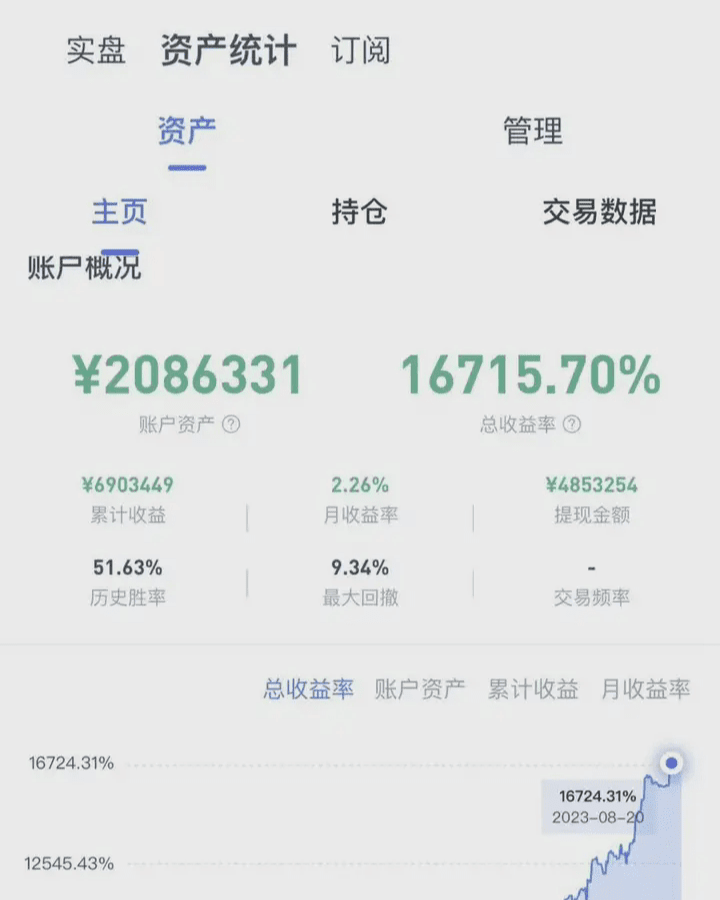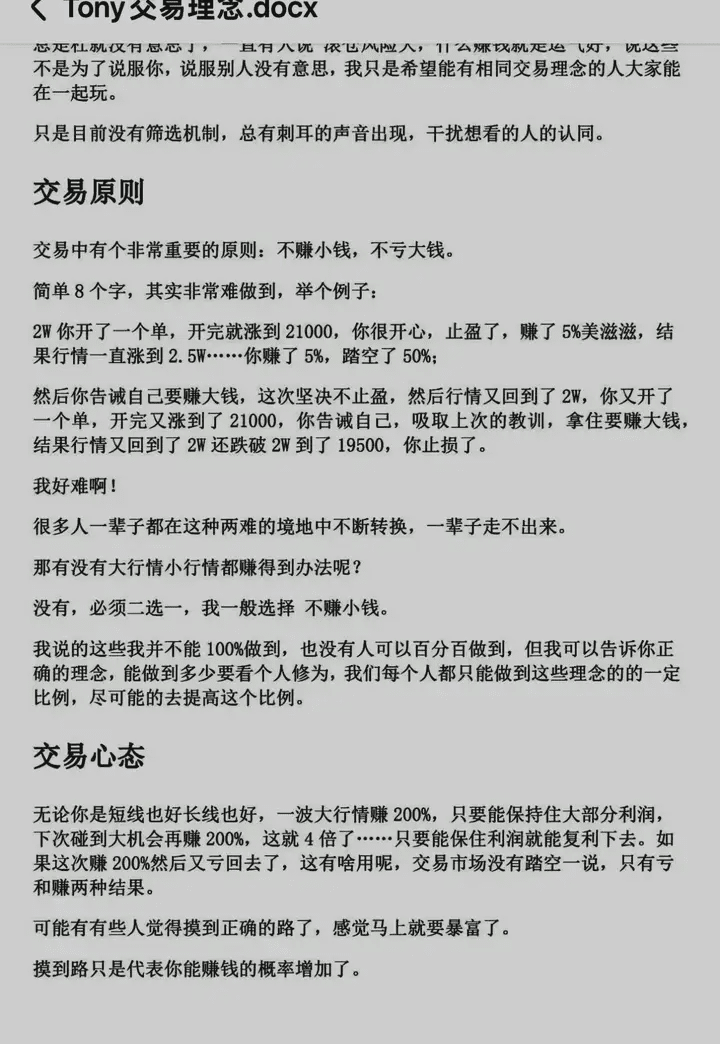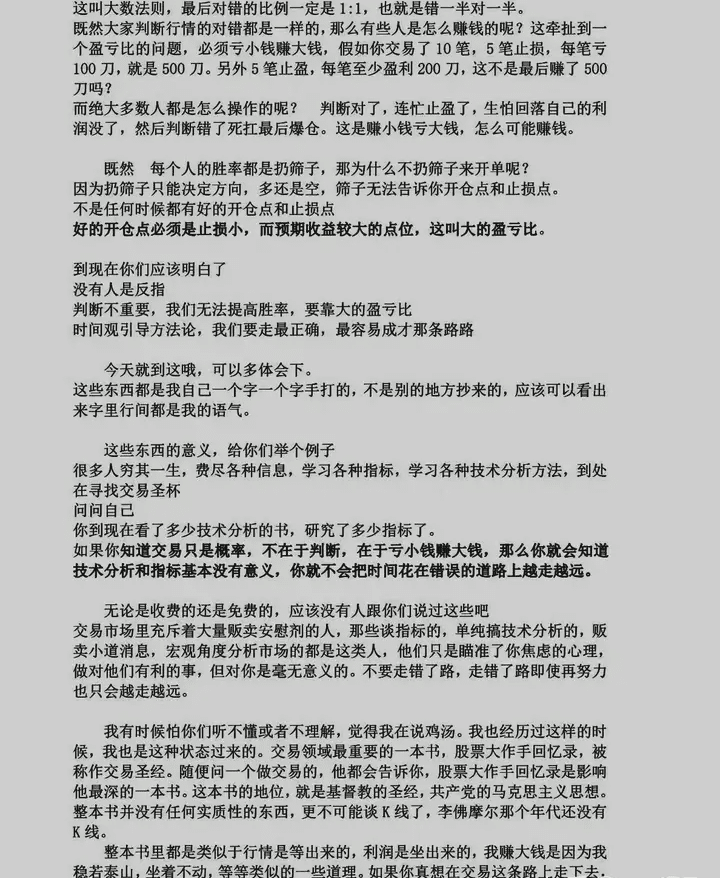In fact, this is not the case. Most people regard contracts as poison, but they don’t realize the importance of lack of knowledge. If you are a loser who doesn’t play contracts, how can you get rich by hoarding big contracts?
Contracts are not scary. Find the bottom to open a position. Before opening a position, be sure to calculate how much loss the stop loss can withstand. If you are right, hold on to it. If you are wrong, stop loss. Do it repeatedly, and making money is that simple.
Many people regard contracts as poison because they see them as casino tools. Remember, students, we are speculators, not gamblers.
There are many experts in contract trading. Here are some suggestions from God C on contract trading:
1) Take a gamble at a low price and just lie flat, don’t be washed out by the dog market, take the trend order, make big profits, it is useless to just short sell.
2) Don't roll or cover your position after opening it. Before placing an order, you must anticipate all possible scenarios and set a stop-loss. If you cover your position later, it means you were wrong from the start, and what's the point of playing the game if you're wrong? Rolling your position can easily lead to being wiped out by a scammer. (I learned this the hard way. C-speaker called for OMG 20X in mid-August. OMG started at $5 at the time... I opened it at 30X, then foolishly used my floating profits to roll over other altcoins. Then, during the 9.7 pullback, my position was wiped out. Now, looking at OMG at $15, I was pissed off.)
3) You can choose to go long or short, but I still recommend that you, the gambler who plays contracts, go long because there's unlimited upside potential, and you can make a lot of money by catching a trend. To make big profits from shorting, you have to keep rolling your position during the trend, but this makes it easy to get wiped out by a rebound from the gambler.
Here are the seven taboos of making contracts
1. Holding position syndrome This is a common problem among investors. The "symptoms" are: when there are no orders in hand, they can't sit still and have to place orders; when there are orders in hand, they panic and don't know what to do once the market moves in the opposite direction; they think that opportunities are endless and always want to keep operating, but the more they operate, the more they lose, and the more they lose, the more they operate.
2. Frequent "all-weather" trading. Many investors want to be all-around players, going short after going long, and long after going short. Although they are very strict with themselves, this goes against the importance of following market trends. Unless one force breaks another, don't think about going against the trend. In a bull market, go long, close long, go long again, close long again... In a bear market, insist on opening short, closing short, opening short again, and closing short again...
3. Countdown-to-trend rebounds. Is it possible to take advantage of a rebound? If you use the right method, of course you can. Otherwise, it's like walking on the edge of a knife. If a knife falls from the sky, when should you catch it? Without a doubt, wait until it hits the ground and becomes immobile. Otherwise, you'll be deeply wounded. Taking advantage of a rebound requires skill. Inexperienced investors shouldn't take risks; simply follow the trend. When participating in a rebound, be sure to carefully manage your funds.
4. Hesitation when placing orders. Fear of being lured into buying when going long, fear of false breakouts, and fear of being tempted into selling when going short, causing opportunities to slip by without purpose. Understanding the inertia of a train after it starts moving, when a trend takes its first step, we follow suit within a step and a half, until the equilibrium is broken. Once the trend is established, we adopt a "take it all" strategy. When signs of a false breakout appear, the odds of winning in the opposite direction are very high.
5. The mindset of the major players watching the market. Many investors have experienced this: when you go long, the market falls; when you go short, the market rises; when you cut your long position, the market rises again; when you cut your short position, the market falls. Luck is sometimes crucial in Bitcoin trading, and the major players don't need you to be so cautious. Immediately shut down your computer, take a break, and try again after calming down.
6. Fully invested: While fully invested can quickly increase your wealth, it's also more likely to lead to a quick loss of your position. Nothing is absolute; even funds can't completely control the impact of unexpected events, policies, or news. Never fully invest. Each open position should not exceed 30% of your total funds, and a maximum of 50% to prevent margin calls or other situations.
7. Refusing to admit defeat. Many investors are stubborn and never admit defeat when they make a mistake. They fail to address their erroneous orders immediately, allowing mistakes to continue unabated. The consequences are unimaginable. "I just don't believe it won't go up, I just don't believe it won't go down..." This mentality is absolutely unacceptable. When admitting a mistake, don't be complacent and resolutely cut your losses immediately.



Continue to pay attention to $BTC ETH PEPE




